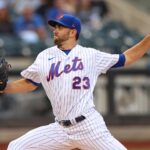There were some complaints about the method I used to grade the 2005 draft so I am going to try and make some adjustments with this version. I am going to do everything I did last time, but in addition to those strategies I am going to take an individual look at the Mets picks in the top 10 rounds.
Although I personally detest when this is done, I will also include some good player the Mets could have taken with their respective pick if they were fortune tellers, so it is not like I am leaving anything out of the conversation. Note: The players had to be taken after the Mets pick in that round.
1st Round (18th overall): Lost pick as compensation for signing Billy Wagner. (Phillies drafted Kyle Drabek with the pick).
Well that certainly stings.
2nd Round (62nd overall): Kevin Mulvey, RHP – Villanova
Mulvey was considered a steal this late in the draft. Baseball America had said about him, “Mulvey doesn’t figure to last past the Phillies at No. 37 overall and could go before that”. He was a college workhorse, with good command three average to slightly above-average pitches, and could reach the majors quickly.
For the 2006 and 2007 Mulvey looked like the real deal. He was already in Triple-A by the end of his first full season and looked like he was only a few months away from contributing at the big league level. The Mets sold high on Mulvey and used him as a piece in the Johan Santana deal that summer.
In 2012 Mulvey seems to be a classic Quadruple-A player. He has not had much of a window to show his worth in the majors, but in his limited action he has been dreadful. Things look like they fell apart for him last year while in the Diamondbacks organization, but he is still just 26 even if at this point his career isn’t expected to amount to much at all.
Grade: If Phil Humber succeeded this one goes down as an incomplete for now.
Mets missed out on: Trevor Cahill, Justin Masterson, and Jon Jay.
3rd Round (94th overall): Joe Smith, RHP – Wright State
It is unusual for a small college reliever who was forced to walk on the team to get drafted this high, but Smith is an unusual pitcher. He adopted his sidearm delivery while in college and took to it immediately, seeing gains on his fastball velocity as well as added movement on his fastball and slider. His new tools allowed him to post a 0.75 ERA in college and the Mets were hoping he could move through the system quickly and help a team that was close to contention.
Smith did just that and won a spot in the bullpen out of spring training in 2007 to make him the second player from the 2006 draft class to reach the majors. He instantly became a fan favorite because of his success and funky delivery, however, after two seasons the Mets decided to trade Smith as part of the J.J. Putz deal in the 2008 off-season. The theory behind that one was to strengthen the bullpen…
Smith has continued his success with the Cleveland Indians and currently has the highest WAR of any player selected in the 3rd round.
Grade: Successful selection by the Mets.
Mets missed out on: No one
4th Round (124th overall): John Holdzkom, RHP – Salt Lake CC
This was the first head-scratcher of the draft. Holdzkom was looked at as a big guy with big time stuff, but he had no command and was considered a head case—he was academically ineligible in high school and dropped out of community college because he got into an argument with his coach. It was an overdraft to say the least.

As expected, Holdzkom showed the big stuff, but hadn’t a clue how to throw a strike. Eventually his poor mechanics and need to throw the ball through a break wall caught up to him and he needed Tommy John surgery in 2009. He came back briefly in 2010, but was released by the Mets in 2011.
To me Holdzkom will be nothing more than that guy who looked like Napoleon Dynamite. If for some reason you would like to read a report on Holdzkom’s potential before his Tommy John surgery, this was a great piece written by Mike Sullivan of Scouting the Sally.
Grade: A complete bust in every way possible. This one could have easily been called at the time of the draft.
Mets missed out on: Chirs Johnson
5th Round (154th overall): Stephen Holmes, RHP – University of Rhode Island
Holmes was as dominant as any college pitcher over his three year career, but only had average stuff that played up because of his command and bull dog mentality. Unfortunately tragedy of a close one struck Holmes just after he signed and he decided to return to school instead of playing professional ball. He attempted to come back with the Mets in 2008, however, in the process he tore his rotator cuff and has yet to pitch a professional inning to this day. I guess this is one of those that we will just never know. Sad.
Grade: Unknown?/No contest
Mets missed out on: David Herndon
6th Round (184th overall): Scott Schafer, RHP – Pasadena Memorial HS
Ah the legend of Scott Schafer. Schafer was considered an overdraft, so he quickly took his money and signed with the team. He had some upside, but was your cliche high school arm with some okay stuff, no polish, and projection.
Much to everyone’s surprise, he never allowed an earned run in his Mets career…because it lasted all of two innings. To put a long story short the kid was an ignoramus. For details of his escapades you can read them here.
Grade: Mark this one down as a major bust.
Mets missed out on: Andrew Bailey (in their own backyard!) and Bud Norris
7th Round (214th overall): Daniel Stegall, OF – Greenwood HS
Stegall is the type of pick Mets fans drool over. He was a two-sport star with a commitment to play quarterback and “The U” of Miami. He had a ton of tools and the Mets got him to sign for relatively cheap price. As tends to happen with those types of players they either turn into stars or never make it past A-ball. Unfortunately Stegall turned out to be one of the guys who never makes it past A-ball because his tools just never translate to the baseball diamond. He finished with a career line of .219/.296/.299 before being released in 2009.
Grade: Classic bust.
Mets missed out on: No one
Round 8 (244th overall): Nathan Hedrick, RHP – Barton Country CC
Hedrick was an imposing presence on the mound at 6’10” and listed at 215 lbs., although it certainly looked like he weighed more. At the time of the draft he only threw in the upper-80’s and had a “frisbee” slider, but was a nice upside play because of the obvious projection in his frame and the fact that was posting great stats despite pitching to tough competition for the first time (he was home schooled in high school and never faced top guys). In his brief stint with the Mets he showed atrocious command with a 7.9 BB/9 and was released by the Mets in 2008.
Grade: Yet another classic bust.
Mets missed out on: Dellin Betances (This is an example of why I hate these things. Everyone new Betances was a top guy, but only the Yankees could sign him so the Mets didn’t really “miss out” here.) and Allen Craig
Round 9 (274th overall): Jeremy Barfield, OF – Klein HS
Barfield was an exciting pick because of his monster power potential with his unbelievable strength and great frame that he inherited from former All-Star father, Jesse Barfield. It seemed ironic that “scouts liked his makeup” because he was arrested shortly after being drafted for throwing his father down the stairs and hospitalizing him. As a result the Mets did not sign Barfield. He is currently in the A’s farm system and has a career line of .264/.334/.394.
Grade: I’m not sure if he counts as a bust since he didn’t sign, but he is definitely close. Wash/No contest.
Mets missed out on: Ryan Kalish and Mark Melancon
10th Round (304th overall): Phillips Orta, RHP – Western Nebraska CC
I remember liking this pick a lot, which in hindsight is clearly a lot more than I should have. He had a mid-90’s fastball and nice curveball in his repertoire that gave him more potential than your average 10th round pick. He actually performed fairly well upon signing with the Mets a draft-and-follow, although as he tried to move through the system is command got worse and worse. Eventually the Mets released him in 2010. He finished his career with a 3.66 ERA and 82:132 BB:K ratio.
Grade: Bust.
Mets missed out on: Kris Medlen
Other picks of note:
13th Round (394th overall): Daniel Murphy, 3B – Jacksonville
This was just a tremendous scouting job by the Mets. Murphy just tore up the minor leagues and quickly made it to the show. He is now the Mets projected second baseman for 2012.
16th Round (484th overall): Tobi Stoner, RHP – Davis & Elkins
Davis & Elkins? I guess by default you have to give the Mets credit for finding a talent in Davis & Elkins that was able to make the major leagues. Stoner only has five MLB appearances and may never see another one after elbow surgery seems to have sapped him off his already fringe stuff. At one time though it did look like he could be a “Dillon Gee” for this ballclub.
26th Round (784th overall): Dustin Martin, OF – Sam Houston State University
Best known for being dealt, along with Drew Butera, for Luis Castillo. Has yet to crack a major league roster, but is still floating around with the Twins’ Triple-A affiliate. He could probably hold down a fifth outfielder role in the mold of Jason Pridie if called upon because of injuries.
37th Round (1114th overall): Josh Stinson, RHP – Northwood HS
A high school pitcher with potential if he made adjustments to his mechanics. He made those necessary corrections and he made the majors in a relief role last year. He didn’t put up stellar numbers, but he is on the 40 man roster and it wouldn’t be surprising for him to see more time with the Mets out of the pen.
Because I went in depth on the picks above, I am only going to give brief comments on the graphs, since they are pretty self explanatory, and then sum everything up.
Now to the statistical comparison side of the case…
I think it is kind of interesting that the exact same number of players from the Mets made the majors from the 2006 draft as the 2005 and that the average numbers of players (4.533 in 2005 and 4.6 in 2006) was practically exactly the same. This has nothing to do with grading the Mets draft just a fun tidbit.
The Mets five players ranks 11th best of all major league teams. The players who made it where Kevin Mulvey (2.62), Joe Smith (3.94), Daniel Murphy (13.394), Tobi Stoner (16.484), and Josh Stinson (37.1114).
This graphs demonstrates how this draft was dominated by a few teams and the majority of the draft classes were pretty terrible, I will touch on this later. Again the Mets are right at the average and their 6.1 WAR is 12th best and is lead by Daniel Murphy (3.5 WAR) and Joe Smith (3.4 WAR).
The Mets aren’t still reaping the (minimal) rewards of this as they are from the 2005 draft. Murphy and Josh Stinson were the only ones to contribute and Stinson didn’t even do all that much to help the team win.
Summary:
Of the Mets picks in the top 10 rounds they have one success, five busts, one incomplete, and two no contests. It doesn’t take a theoretical physicist to figure out those are not good results.
The Mets had a clear type when drafting in the early rounds. They went heavy on pitchers, and more specifically pitchers who were behemoths and/or had a fastball but nothing else. That plan did not turn out very well.
Schafer, Stegall, and Barfield are the perfect examples of the danger of drafting high school players. Stegall based on the obvious fact that you just never know how their skills will develop and Schafer and Barfield go beyond that to the maturity and makeup factors.
The only of the early picks that have had any form of success were the two college guys at the top who were the “safer” picks.
The Mets desperately saved this class with outstanding job of scouting Murphy. Getting Stinson that late was nice, but he was pretty well known at the time of the draft. Murphy on the other hand had no buzz despite great performances at Jacksonville. This is one we owe to Tony Bernazard because I doubt the Mets even know who Daniel Murphy was had Murphy not played on Tony’s son’s team.
Overall, as evidenced by the WAR graph, this was a very weak draft for everyone—not just the Mets. Of the 30 first round picks only 7 have a career WAR above 1.5 for their career. That is not good. Granted some of the high school guys are just getting established and show some potential (Snider, Marrero, Jeffress, Drabek, Parmelee, Cogner), but they are far from a guarantee to switch this from a poor to a good first round.
If I had to grade this draft only by the Mets’s success at finding players, taking into consideration they had no first round pick, I could probably only give it a D+. If I take into account the relativity of how poor this class as a whole looks right now, I would be around a C+/B-. Because of that I think it is only fair to give Omar a grade somewhere in the middle.
Final Grade: C-

















